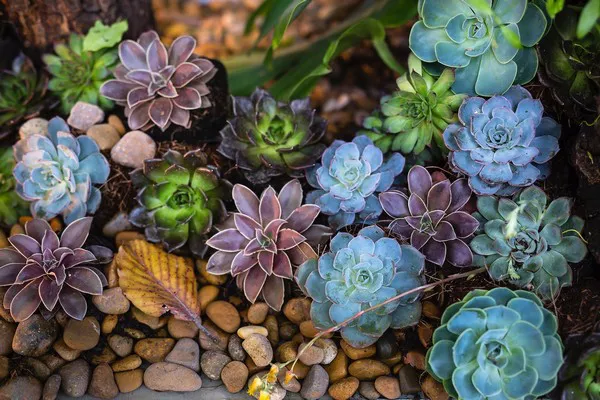Succulents, with their striking forms and captivating resilience, have taken the gardening world by storm. Beyond their captivating leaves, these plants surprise enthusiasts with another remarkable feature: flower stalks. Succulent flower stalks, often overlooked, hold a world of beauty and potential that can enhance the overall appeal of these plants. In this comprehensive guide, we will explore the intriguing realm of succulent flower stalks, from their emergence and care to propagation and creative utilization.
The Emergence of Succulent Flower Stalks: Nature’s Delicate Symphony
1. A Marvel of Nature: Succulent flower stalks emerge as a testament to the plant’s vitality and reproductive prowess. When conditions are favorable, succulents transition from a phase of growth to focus their energy on producing vibrant and often intricate blooms.
2. Timing and Triggers: Flower stalk emergence varies among succulent species and is often influenced by factors such as seasonal changes, age, and environmental cues. Understanding these triggers can help anticipate when your succulents might bloom.
3. Display of Diversity: Succulent flowers come in an array of shapes, colors, and sizes, reflecting the astounding diversity of this plant family. From the dainty stars of Echeveria to the cascading clusters of Sedum, each succulent type brings its unique floral spectacle.
Caring for Succulent Flower Stalks: Nurturing Beauty to Full Bloom
1. Light Requirements: Adequate sunlight is crucial for the development of healthy flower stalks. Ensure your succulents receive the right balance of direct and indirect sunlight to promote robust flowering.
2. Watering Considerations: As succulent flower stalks begin to form, adjust your watering routine to provide slightly more moisture than usual. However, be cautious not to overwater, as succulents are susceptible to root rot.
3. Nutrient Boost: A diluted, balanced fertilizer applied during the growing season can provide the extra nutrients necessary for optimal flower development. Remember to follow the recommended dosage to avoid over-fertilization.
4. Pest Management: Regularly inspect your succulents for pests that might hinder flower stalk growth. Common culprits include aphids, mealybugs, and spider mites. Swift action can prevent infestations from diminishing the beauty of your blooms.
5. Pruning Practices: Removing spent or faded flowers not only improves the plant’s appearance but also directs its energy toward producing new buds. Use clean, sterilized tools to prevent the spread of disease.
Propagation through Flower Stalks: Cultivating New Life
1. Seed Harvesting: If pollination occurs, succulent flowers may produce seeds. Harvest these seeds carefully, allow them to dry, and then sow them in a well-draining soil mix. This method offers an exciting opportunity to propagate new succulent generations.
2. Offsets and Pups: Some succulent species, like Sempervivum and Agave, produce offsets or pups at the base of the flower stalk. These tiny clones can be gently separated and planted to establish new plants.
3. Leaf Propagation: While not directly related to flower stalks, leaf propagation is another way to expand your succulent collection. Gently pluck healthy leaves, let them callus, and then place them on moist soil. With time, these leaves can develop into new plants.
Innovative Uses for Succulent Flower Stalks: Unleashing Creativity
1. Floral Arrangements: Incorporate freshly cut succulent flower stalks into floral arrangements for a unique and long-lasting touch. Their striking forms and colors can elevate any bouquet.
2. Dried Flower Crafts: Once the blooms have faded, consider drying the flower stalks for decorative crafts. Their preserved beauty can be showcased in wreaths, potpourri, or framed displays.
3. Living Art: Create living art pieces by framing pressed and dried succulent flowers. Their delicate details can be captured and preserved in a visually appealing composition.
4. Garden Sculptures: Craft intricate garden sculptures using succulent flower stalks as structural elements. Their natural shapes and durability make them excellent candidates for artistic installations.
5. Educational Opportunities: Engage in educational activities by pressing and cataloging succulent flowers. This not only enhances your knowledge but also serves as a valuable resource for fellow succulent enthusiasts.
Conclusion
Succulent flower stalks, often overlooked amidst the allure of vibrant leaves, are a testament to the intricate beauty and resilience of these remarkable plants. By understanding the emergence of flower stalks, nurturing them through careful care, and exploring creative avenues for their utilization, succulent enthusiasts can unlock a world of possibilities. From propagation to artistry, these delicate floral structures add a layer of fascination to the already captivating realm of succulent cultivation. As you embark on your journey of succulent appreciation, remember to cherish every flower stalk as a testament to the plant’s enduring vitality and capacity for expression.


